The Diagnostic Imaging Markers Market is estimated to be valued at USD 1.3 billion in 2025 and is projected to reach USD 2.2 billion by 2035, registering a compound annual growth rate (CAGR) of 5.6% over the forecast period.
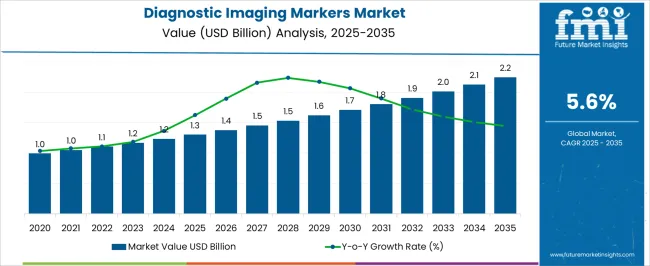
| Metric | Value |
|---|---|
| Diagnostic Imaging Markers Market Estimated Value in (2025E) | USD 1.3 billion |
| Diagnostic Imaging Markers Market Forecast Value in (2035F) | USD 2.2 billion |
| Forecast CAGR (2025 to 2035) | 5.6% |
The Diagnostic Imaging Markers market is experiencing consistent growth as medical imaging continues to play a central role in the early detection, diagnosis, and monitoring of chronic and acute diseases. The current market landscape reflects rising adoption of advanced imaging techniques across hospitals and diagnostic centers, driven by the growing burden of cancer, cardiovascular conditions, and neurological disorders.
Increasing investments in healthcare infrastructure and technological improvements in imaging modalities are supporting this trend, alongside the need for precise, non-invasive diagnostic methods. The use of markers is being elevated by the demand for accuracy, speed, and integration of imaging with digital healthcare systems.
Furthermore, the shift toward value-based healthcare and emphasis on early intervention have strengthened the position of imaging markers as a critical tool in clinical workflows The future outlook of this market is shaped by growing collaborations between imaging technology developers and healthcare providers to enhance diagnostic accuracy, reduce procedural risks, and optimize patient outcomes, thereby paving the way for sustained expansion.
The diagnostic imaging markers market is segmented by application, end users, and geographic regions. By application, diagnostic imaging markers market is divided into X-ray, Bone Scan, DEXA Scanning, Mammography, Ultrasound, Magnetic Resonance Imaging, Positron Emission Tomography Scan, Computed Tomography Scan, and Other. In terms of end users, diagnostic imaging markers market is classified into Hospitals, Diagnostic Centers, Radiotherapy Centers, Clinics, and Others. Regionally, the diagnostic imaging markers industry is classified into North America, Latin America, Western Europe, Eastern Europe, Balkan & Baltic Countries, Russia & Belarus, Central Asia, East Asia, South Asia & Pacific, and the Middle East & Africa.
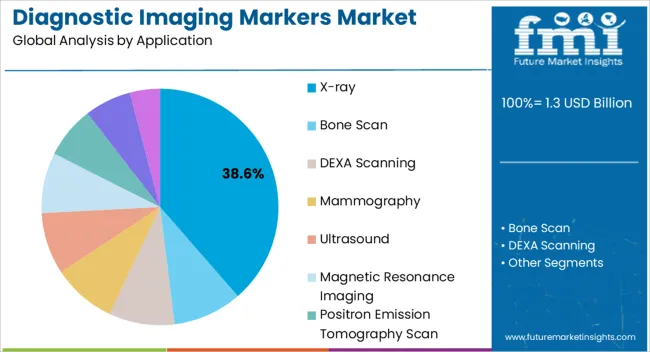
The X-ray application segment is anticipated to account for 38.60% of the Diagnostic Imaging Markers market revenue in 2025, establishing it as the leading application area. This dominance is being attributed to the widespread accessibility and cost-effectiveness of X-ray imaging across global healthcare systems. The growth of this segment has been influenced by its essential role in diagnosing bone disorders, chest conditions, and various acute medical emergencies where immediate results are required.
Diagnostic markers integrated with X-ray platforms provide enhanced visualization of abnormalities, thereby improving accuracy in clinical decision-making. Hospitals and clinics continue to rely on this modality due to its rapid turnaround time, low operational costs, and ability to integrate with digital imaging archives for longitudinal patient monitoring.
The affordability of X-ray compared to other modalities has also encouraged adoption in emerging healthcare markets, reinforcing its position as the leading application As technology advances, further improvements in image quality and marker sensitivity are expected to strengthen the X-ray segment’s sustained market share.
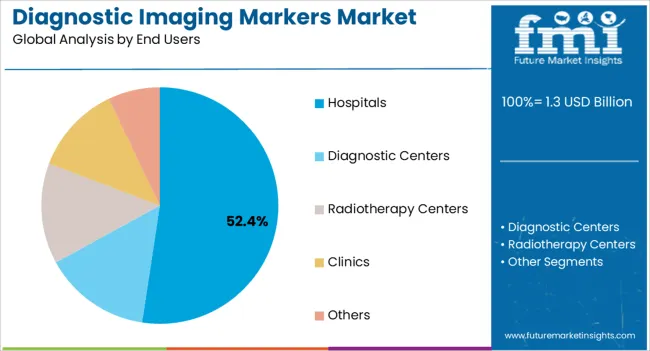
The Hospitals end-user segment is projected to hold 52.40% of the Diagnostic Imaging Markers market revenue in 2025, making it the most dominant sector. This leadership is being driven by the high patient inflow in hospital settings, where comprehensive diagnostic services are a critical part of care delivery. Hospitals have been at the forefront of adopting advanced imaging technologies, supported by substantial investments in infrastructure, availability of skilled professionals, and integration with multidisciplinary treatment teams.
The use of imaging markers in hospitals is further reinforced by their ability to support accurate diagnosis across diverse clinical areas including oncology, cardiology, orthopedics, and neurology. The concentration of advanced equipment within hospitals allows for both routine and specialized imaging services, which has strengthened reliance on these facilities as primary diagnostic hubs.
Moreover, the growing focus on precision medicine and early detection in hospital environments has amplified the demand for marker-based imaging Continued expansion of hospital networks and emphasis on advanced patient care are expected to ensure this segment’s leadership in the market.
The use of electromagnetic radiation and related technologies to obtain images of internal structures of the body for accurate diagnosis is known as medical or diagnostic imaging. A diagnostic imaging marker is a biomarker or a biologic feature that is detectable in an image. This image is relevant to the diagnosis of a patient for a certain disease.
Diagnostic imaging includes certain radiation technique; X-Ray imaging, endoscopy, magnetic resonance imaging, computed tomography scan, ultrasound etc. The diagnostic imaging markers are either placed in or around the part of the body that needs to be screened. These markers help in target localization of the tumor or the diseased organ. Digital imaging markers aid in knowing the exact position of the tumor, further depicting the severity, shape and size of the diseased organ/ tumor.
Diagnostic imaging markers are highly used for cancer diagnosis. For instance, for lung cancer, these diagnostic imaging markers can be used for the assessment the calcification, cavitation, speculation, rate of growth, location within the lung, and rate of metabolism of the tumor.
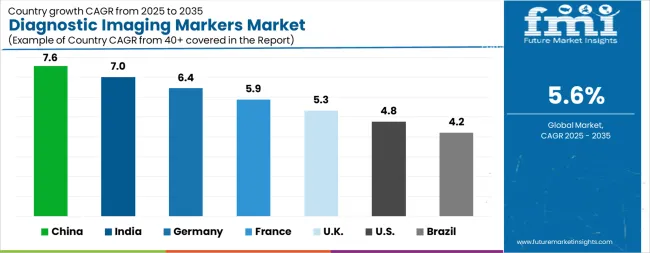
| Country | CAGR |
|---|---|
| China | 7.6% |
| India | 7.0% |
| Germany | 6.4% |
| France | 5.9% |
| UK | 5.3% |
| USA | 4.8% |
| Brazil | 4.2% |
The Diagnostic Imaging Markers Market is expected to register a CAGR of 5.6% during the forecast period, exhibiting varied country level momentum. China leads with the highest CAGR of 7.6%, followed by India at 7.0%. Developed markets such as Germany, France, and the UK continue to expand steadily, while the USA is likely to grow at consistent rates. Brazil posts the lowest CAGR at 4.2%, yet still underscores a broadly positive trajectory for the global Diagnostic Imaging Markers Market. In 2024, Germany held a dominant revenue in the Western Europe market and is expected to grow with a CAGR of 6.4%. The USA Diagnostic Imaging Markers Market is estimated to be valued at USD 475.0 million in 2025 and is anticipated to reach a valuation of USD 756.3 million by 2035. Sales are projected to rise at a CAGR of 4.8% over the forecast period between 2025 and 2035. While Japan and South Korea markets are estimated to be valued at USD 61.1 million and USD 35.6 million respectively in 2025.
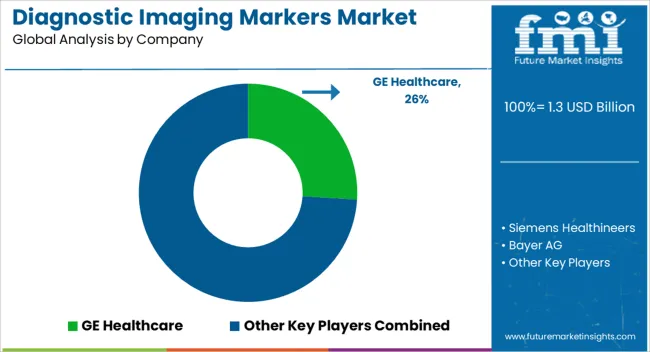
| Item | Value |
|---|---|
| Quantitative Units | USD 1.3 Billion |
| Application | X-ray, Bone Scan, DEXA Scanning, Mammography, Ultrasound, Magnetic Resonance Imaging, Positron Emission Tomography Scan, Computed Tomography Scan, and Other |
| End Users | Hospitals, Diagnostic Centers, Radiotherapy Centers, Clinics, and Others |
| Regions Covered | North America, Europe, Asia-Pacific, Latin America, Middle East & Africa |
| Country Covered | United States, Canada, Germany, France, United Kingdom, China, Japan, India, Brazil, South Africa |
| Key Companies Profiled | GE Healthcare, Siemens Healthineers, Bayer AG, Bracco Imaging S.p.A., Guerbet Group, and Lantheus Holdings, Inc. |
The global diagnostic imaging markers market is estimated to be valued at USD 1.3 billion in 2025.
The market size for the diagnostic imaging markers market is projected to reach USD 2.2 billion by 2035.
The diagnostic imaging markers market is expected to grow at a 5.6% CAGR between 2025 and 2035.
The key product types in diagnostic imaging markers market are x-ray, bone scan, dexa scanning, mammography, ultrasound, magnetic resonance imaging, positron emission tomography scan, computed tomography scan and other.
In terms of end users, hospitals segment to command 52.4% share in the diagnostic imaging markers market in 2025.






Full Research Suite comprises of:
Market outlook & trends analysis
Interviews & case studies
Strategic recommendations
Vendor profiles & capabilities analysis
5-year forecasts
8 regions and 60+ country-level data splits
Market segment data splits
12 months of continuous data updates
DELIVERED AS:
PDF EXCEL ONLINE
Diagnostic Shipper Market Size and Share Forecast Outlook 2025 to 2035
Diagnostic Vials Market Size and Share Forecast Outlook 2025 to 2035
Diagnostic X-Ray System Market – Trends & Forecast 2025 to 2035
Diagnostic Tools for EVs Market Growth - Trends & Forecast 2025 to 2035
Breaking Down Diagnostic Vials Market Share & Industry Insights
Diagnostic Stopper Market
Diagnostic Exosome Biomarkers Market Trends – Growth & Forecast 2025 to 2035
Diagnostic Imaging Services Market Size and Share Forecast Outlook 2025 to 2035
DNA Diagnostics Market Growth - Trends & Forecast 2024 to 2034
HIV Diagnostics Market Overview - Trends & Forecast 2024 to 2034
Food Diagnostics Services Market Size, Growth, and Forecast for 2025–2035
Rabies Diagnostics Market Size and Share Forecast Outlook 2025 to 2035
Cancer Diagnostics Market Analysis - Size, Share and Forecast 2025 to 2035
Tissue Diagnostics Market Size and Share Forecast Outlook 2025 to 2035
Sepsis Diagnostics Market Growth - Trends & Forecast 2025 to 2035
Dental Diagnostic and Surgical Equipment Market Analysis - Trends & Forecast 2024 to 2034
Poultry Diagnostic Testing Market Size and Share Forecast Outlook 2025 to 2035
Poultry Diagnostics Market - Demand, Growth & Forecast 2025 to 2035
Protein Diagnostics Market Share, Size and Forecast 2025 to 2035
Allergy Diagnostic Market Report – Growth & Forecast 2024-2034

Thank you!
You will receive an email from our Business Development Manager. Please be sure to check your SPAM/JUNK folder too.
Chat With
MaRIA